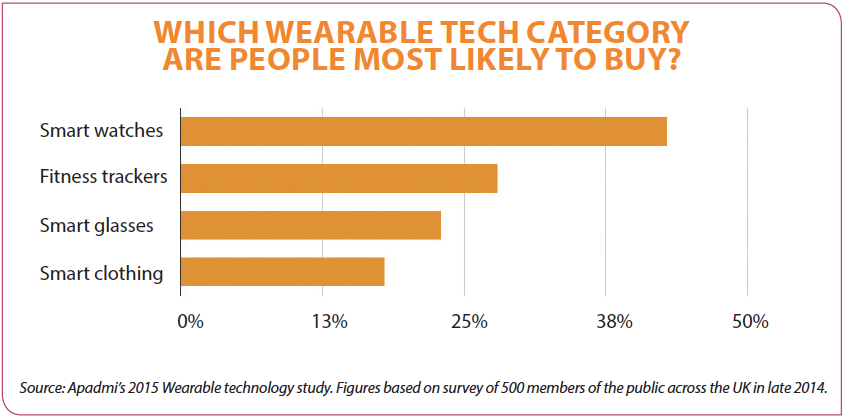Wearable technologies have gained increasing traction in recent years, particularly with the much hyped launch of the Apple Watch in April.

If you read nothing else, read this…
- Data collected from wearable devices can provide meaningful insights for both employers and individual users.
- An effective communication strategy and supportive culture can enhance the take-up and continued use of wearable devices.
- Wearables may become more widespread in the workplace as the sophistication and functionality of the technology increases.
Approximately six million people are expected to own a wearable device by September 2015, according to YouGov’s Wearables tracker research 2014, published in October 2014. Furthermore, almost a fifth (18%) of employees in Europe have access to some form of wearable technology at work, according to research by human capital management provider ADP, Tools and technology: Europe at a glance, published in July 2015.
However, it is in the health and wellbeing space that wearable devices are having the biggest impact, and perhaps the greatest potential, for organisations and their staff.
There is a range of wearable health and fitness technology on the market, from simpler devices such as pedometers to more intuitive trackers such as Fitbug Orb, Jawbone and Fitbit. Employers are making such technology available to their workforces in a number of ways, including discount schemes or as a free provision through certain insurance products.
So how can employers utilise this technology to enhance the wellbeing of their staff, and what hurdles may need to be overcome when positioning wearable devices within workplace health programmes?
Supplying insights and informing strategy
Calories burnt, miles run, sleep patterns and resting heart rate are just some of the metrics that wearable trackers can collect. These insights can provide the wearer with a baseline knowledge of their personal fitness level along with the tool to measure activity patterns and improvement rates. As Chris Evans, senior consultant at Buck Consultants, says: “The important thing is that it’s raising people’s awareness of how much, or indeed how little, they are moving around.”
Data can also be used by employers to identify areas of concern and to gain a better understanding of how their staff engage with health and fitness, which can ultimately be used to inform their health and wellbeing strategy. Paul Shires, sales and marketing director at Westfield Health, explains: “It’s a way of getting an anonymised report on health and wellbeing for [an] organisation. On the back of that data [employers] can start to run relevant and appropriate campaigns.”
While the information collected by wearables is one of the greatest advantages it provides to both employers and staff, it can also be perceived with some trepidation. Some employees may have concerns around privacy but data is subject to protection and if employers do opt to collect data through an aggregation tool, it is at an anonymous, organisational level. Employers can help dispel misconceptions via thorough and transparent communication about how wearable technology works and why it is being made available to staff.
Engagement and usage
When it comes to workplace demographics, there may be assumptions about how different groups will respond to wearable technology. While tech-savvy generations Y and Z may be seen as the most likely to engage with digital devices, take-up may be faster among baby boomers and the first wave of generation X, who may be driven by a more immediate need to embrace technologies that could help them manage serious health conditions, says Matthew Lawrence, head of broking and proposition for health and risk at Aon Employee Benefits.
The diverse levels of fitness within a workforce may also be a factor to take into consideration when designing a health strategy that incorporates wearable devices. Evans explains that trackers have historically been geared to those who are already highly engaged with fitness. “Almost by definition, this then alienates the people who would perhaps most benefit from these devices, although there are a few things that can be done to overcome this,” he says.
The initial introduction of simpler, single-function devices such as pedometers is one such method, says Westfield Health’s Shires. “Those types of technology can make sure [employers] get engagement from the widest possible population, but the more advanced technology can help an [organisation] create much more meaningful health and wellbeing strategies beyond just engagement [by providing a data point].”
Communication and workplace culture are also key to both maximising the benefits provided by wearable technology and driving long-term behavioural change. John Dean, managing director of Punter Southall Health and Protection, says: “Giving someone a wearable device but then not giving them any cultural change is a bit pointless.”
He adds that cultural change could include encouraging staff to walk to work, providing shower and changing facilities for those who exercise at lunchtime or organising fitness challenges and sports clubs.
Future trends
As wearable technology develops, so too will the way in which it serves employers and their workforce. Increased competition and market presence may drive down manufacturing and purchase costs, providing an even greater return on investment. As Dean explains, not only can the devices improve staff health and boost productivity rates; they can also reduce costs relating to sickness absence and private medical insurance.
Improved functionality, design and usability are also areas for projected development. Data accuracy and presentation could make wearables an increasingly attractive prospect, both for organisations and individuals. Lawrence says: “The challenge for technology firms surrounds making the data much more compelling. If they can get that right, then I think wearables will become much more mainstream.”
Widening their focus from fitness to deeper health metrics, such as tracking blood sugar levels, could also see wearable technology expand from the preventative space into the management of longer-term health issues and perhaps even diagnosis. As Shires says: “We haven’t seen anything yet.”

Viewpoint: Behavioural profiling completes insight jigsaw

Workplace wearables promise a new future in workplace analytics, and data from human beings is one of the missing pieces in harnessing value and strategic insight from the big data puzzle in organisations.
Economically, the price of sensors, processors and networking continues to fall in real and relative terms. Technically, exponential advancements propel smaller, faster, more reliable and more powerful wearable data collection. But it is advancements in behavioural economics and profiling that promises the greatest potential impact of wearables on workplace culture and operations.
The practical, legal and ethical hurdles to mainstream wearable workplace adoption are starting to resolve and evolve. Employees are also less likely to reject wearable interventions in work-life balance. Research by PricewaterhouseCoopers (PWC), based on a survey of 2,023 working UK adults in January 2015, indicates that more than half of employees would wear a smartwatch if their data was used to improve workplace wellbeing by analysing impact on working hours, stress levels, work environment and location, free health screening or health and fitness incentives. More than seven in 10 millennial workers (born between 1980 and 1995) would wear a work-issued smartwatch if it involved some form of value exchange with their employers.
There are three immediate opportunities for organisations seeking to harness the power of wearables in workplace wellbeing, safety and productivity. First, provide opportunities for employees to learn about themselves through data and provide pathways for self-improvement. In all of our studies, employees are consistently startled by what wearable data correlated with other measures can tell them about their productivity, performance, alertness and even job satisfaction.
Second, enhancing teamwork and co-ordinating workforces. Individual wearable data is useful but it is in aggregate and in the interactions between employees that patterns and trends are revealed in the same way that sports science looks at teams through both the nodes of individual performances and the network interactions of data points.
Third, upgrading the analytics capacities of human resources and the management techniques for human capital. Making sense of wearable data in the workplace requires both imagination and experimentation in correlations and technical expertise to analyse and draw useful conclusions.
Dr Chris Brauer is director of innovation and senior lecturer in the Institute of Management Studies, Goldsmiths.
Chris Brauer will discuss wearable technology in the closing keynote session ’Wearable technology – the future of workplace health?’ on 21 September at Employee Benefits Live. View the full conference programme and register to attend.
Case study: Dixons Carphone boosts wellbeing with wearables

On 11 and 12 July 2015, around 200 Dixons Carphone employees participated in a gruelling ultra-challenge, in which they ran, trekked and walked 100km from Lewknor in Oxfordshire to the Avebury stone circle in Wiltshire.
Of these 200, 12 were part of the organisation’s Average to Awesome (A2A) challenge. Following an application and selection process, those in the A2A team received additional support to help them reach their fitness goals and successfully complete the race. This included custom-fit trainers and a personal training regime devised by Rory Coleman, a Guinness World Record holder with more than 900 marathons and 230 ultra-marathons under his belt.
While this is the second year that the electrical and telecommunications retailer has supported the event, known as the Dixons Carphone Race to the Stones, it is the first year that it introduced wearable technology into the training mix. A Fitbit Surge was given to everyone on the A2A team.
This initiative was driven by Dixons Carphone’s interest in introducing technology into the scheme, an awareness that some of its 27,000 UK- and Ireland-based staff were already using wearable devices for their personal fitness, along with the aim of boosting motivation. Those on the A2A challenge could set up competitions and training groups using the devices, allowing them to encourage one another no matter where they were based. Kesah Trowell, head of corporate and social responsibility (CSR) at Dixons Carphone, says the technology made a noticeable difference and there are plans to use it again next year. “[Participating employees] look fitter, they are fitter, and they’ve got a different mental outlook,” says Trowell.
The organisation also supports employee fitness outside of the A2A challenge, including weekly emails with health, training and nutrition tips, as well as discounts for those wanting to purchase wearable devices. It intends to increase its staff wellness offerings around the event to build upon the success achieved thus far.
The event has also helped to improve employee communication across locations and business functions, an added bonus for the organisation, which was established through the merger of Carphone Warehouse and Dixons Retail in August 2014. Trowell adds: “With the businesses merging, it was really great to get people from different sides of the business together in this great challenge.”